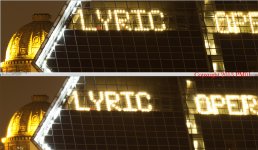Top pic is with the AP scope and field flattener. Bottom pic is with the "brand C" lens, stabilized, 800mm class used by a "morris". $14,000 msrp for the lens that took the pic on the bottom half. This was the best sample out of 5 different "brand C" lenses that I've tried.
Both critically focused manually at 10x. Image stabilizer turned off and with mirror lockup.
Always an interesting comparison.
PM01
Both critically focused manually at 10x. Image stabilizer turned off and with mirror lockup.
Always an interesting comparison.
PM01




